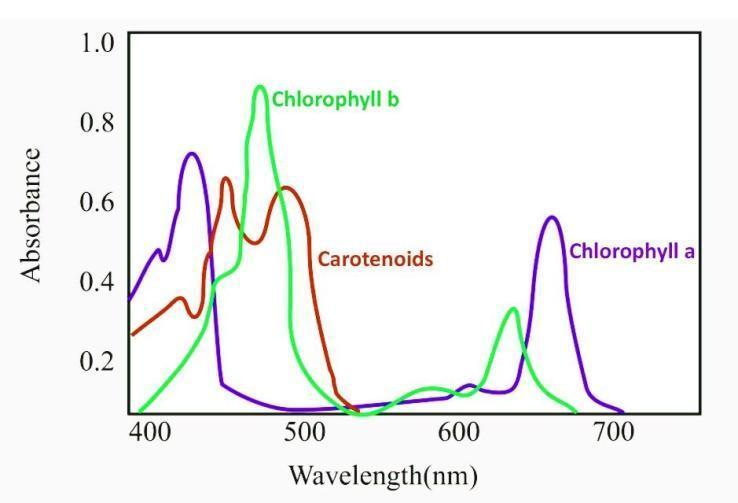
The given graph represents the absorption spectra of three photosynthetic pigments, chl a chl b, and $\beta -carotene$.

Select the correct statement.
(a) The curve showing the amount of absorption of different wavelengths of light by a photosynthetic pigment is called the absorption spectrum
(b) Chl a and Chl b absorb maximum light in the blue and red wavelengths of light.
(c) Rate of photosynthesis is maximum in blue and red wavelengths of light
(d) All of these

Answer
493.8k+ views
Hint: The photosynthetic pigments of a plant do not utilize the sunlight as a whole but pick up specific wavelengths of light to convert it into chemical energy. The pigments also perform most efficiently at a particular wavelength, which is reflected in the graph.
Complete answer: -
In photosynthesis, the sun’s light energy is converted to chemical energy by the photosynthetic pigments present in the organism.
- The graphical curve in the figure showing the amount of energy of different wavelengths of light absorbed by a pigment is called the absorption spectrum.
- Chlorophyll molecules absorb blue and red wavelengths, as shown by the peaks in the absorption spectra in the figure above. The more light absorbed, the higher is the rate of photosynthesis.
Additional Information: -
The wavelengths that pigment doesn't absorb are reflected, and the reflected light is what we see as the color of the plant. For example, plants appear green to us because they contain chlorophyll a and b pigments, which reflect green light.
- The pigments are often named after the wavelength which is maximally absorbed by them, for example, ${ Chl\quad a }_{ 673 }$, ${ Chl\quad a }_{ 683 }({ P }_{ 680 })$, etc.
- $\beta -carotene$ and other carotenoids absorb light in the blue-green and violet region and reflect the longer yellow, red, and orange wavelengths. They also dispose of the excess energy out of the cell.
So, the correct answer is option d) All of these.
Note: -
Absorption spectrum of the substances is measured using a spectrophotometer.
- From the visible spectrum, red light has the longest wavelength and the least energy, while violet light has the shortest wavelength and the most energy.
- Chlorophyll a is present in all photosynthetic plants, algae, and cyanobacteria, while only plants and green algae contain chlorophyll b, along with a few types of cyanobacteria.
Complete answer: -
In photosynthesis, the sun’s light energy is converted to chemical energy by the photosynthetic pigments present in the organism.
- The graphical curve in the figure showing the amount of energy of different wavelengths of light absorbed by a pigment is called the absorption spectrum.
- Chlorophyll molecules absorb blue and red wavelengths, as shown by the peaks in the absorption spectra in the figure above. The more light absorbed, the higher is the rate of photosynthesis.
Additional Information: -
The wavelengths that pigment doesn't absorb are reflected, and the reflected light is what we see as the color of the plant. For example, plants appear green to us because they contain chlorophyll a and b pigments, which reflect green light.
- The pigments are often named after the wavelength which is maximally absorbed by them, for example, ${ Chl\quad a }_{ 673 }$, ${ Chl\quad a }_{ 683 }({ P }_{ 680 })$, etc.
- $\beta -carotene$ and other carotenoids absorb light in the blue-green and violet region and reflect the longer yellow, red, and orange wavelengths. They also dispose of the excess energy out of the cell.
So, the correct answer is option d) All of these.
Note: -
Absorption spectrum of the substances is measured using a spectrophotometer.
- From the visible spectrum, red light has the longest wavelength and the least energy, while violet light has the shortest wavelength and the most energy.
- Chlorophyll a is present in all photosynthetic plants, algae, and cyanobacteria, while only plants and green algae contain chlorophyll b, along with a few types of cyanobacteria.
Recently Updated Pages
Master Class 12 Business Studies: Engaging Questions & Answers for Success

Master Class 12 Economics: Engaging Questions & Answers for Success

Master Class 12 English: Engaging Questions & Answers for Success

Master Class 12 Maths: Engaging Questions & Answers for Success

Master Class 12 Social Science: Engaging Questions & Answers for Success

Master Class 12 Chemistry: Engaging Questions & Answers for Success

Trending doubts
What is meant by exothermic and endothermic reactions class 11 chemistry CBSE

Which animal has three hearts class 11 biology CBSE

10 examples of friction in our daily life

One Metric ton is equal to kg A 10000 B 1000 C 100 class 11 physics CBSE

1 Quintal is equal to a 110 kg b 10 kg c 100kg d 1000 class 11 physics CBSE

Difference Between Prokaryotic Cells and Eukaryotic Cells




